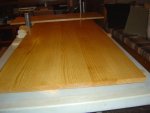Eric Eckman
Member
- Messages
- 20
- Location
- Brunswick, ME
Hello all,
I'm preparing to start work on an office furniture set. I have decided on the design that I like and have found a set of plans to use as a guideline. http://www.woodstore.net/sesedesy.html
I am ready to start on the project, but I'm at the point where I need to choose a wood. I'm new to this whole thing, so I'm looking for a good entry-level hardwood to use for this project. Without having a lot of experience in working with different types of wood, I just don't have enough background knowledge to know what the appropriate material would be. I had been planning to use Oak, but I just found that the lumberyard where I'm going to buy my materials has a special for the month of November on 4/4 Birch for $1.75 bd/ft. Oak will be about $2.30 a bd/ft. I obviously know what Oak looks like in it's finished state because it's so common, but I'm not sure if I have any idea how Birch looks when it's finished. Is this an appropriate wood to use for furniture, and how does it look when it's finished? If birch is good for a piece of furniture like this, how should I go about finishing it? I don't need an extremely durable finish because the actual table surfaces of this piece are made of two layers of MDF covered in laminate.
Thanks for the help guys.
I'm preparing to start work on an office furniture set. I have decided on the design that I like and have found a set of plans to use as a guideline. http://www.woodstore.net/sesedesy.html
I am ready to start on the project, but I'm at the point where I need to choose a wood. I'm new to this whole thing, so I'm looking for a good entry-level hardwood to use for this project. Without having a lot of experience in working with different types of wood, I just don't have enough background knowledge to know what the appropriate material would be. I had been planning to use Oak, but I just found that the lumberyard where I'm going to buy my materials has a special for the month of November on 4/4 Birch for $1.75 bd/ft. Oak will be about $2.30 a bd/ft. I obviously know what Oak looks like in it's finished state because it's so common, but I'm not sure if I have any idea how Birch looks when it's finished. Is this an appropriate wood to use for furniture, and how does it look when it's finished? If birch is good for a piece of furniture like this, how should I go about finishing it? I don't need an extremely durable finish because the actual table surfaces of this piece are made of two layers of MDF covered in laminate.
Thanks for the help guys.




